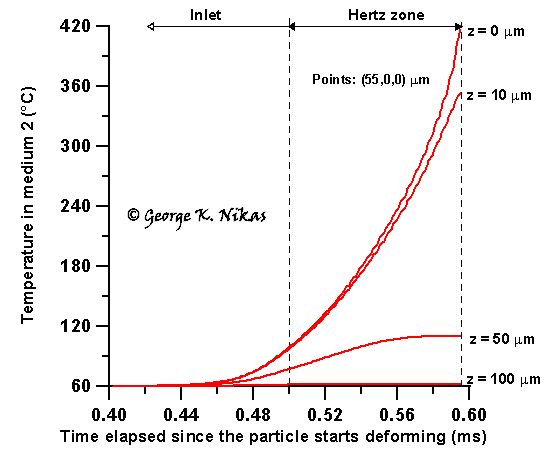
Paper: Thermal modeling and effects from debris particles in sliding/rolling EHD line contacts - A possible local scuffing mode.
Authors: Nikas, G. K., Ioannides, E., Sayles, R. S.
Published
in:
Transactions of the American Society of Mechanical Engineers (ASME), Journal of Tribology, 1999, 121(2), 272-281
Erratum: In Table 5 of the published paper, diameter D of the particle is actually in microns, not in "mm" as misprinted in the paper.
Abstract
The damage caused by debris particles in concentrated contacts has been studied extensively in the past, both theoretically and experimentally. Most of the theoretical studies, in which surface damage was calculated in the form of dents, were performed isothermally. It is known that sliding asperity contacts, which resemble third body contacts, reach high local temperatures that can affect local material properties, which, in turn, will affect the way damage is generated on the surfaces of machine elements. In the present work, the heat transfer of lubricated, rolling-sliding line contacts in the presence of a ductile spherical particle is modelled. The particle is assumed to be significantly softer than the counterfaces that squash it. The local flash temperatures due to the combined sliding and compression of a particle are calculated. It is found that high temperatures caused from small and soft particles are rather the rule than the exception.
Some figures from this work
Figure 1 shows the overall temperature on one counterface at the centre of an elastohydrodynamic contact and at three other depths directly below the surface as a ductile spherical particle passes through the contact and produces heat due to friction as it is compressed and sheared between the sliding counterfaces. The particle is 30 microns in diameter and 8 times softer than the counterfaces of the contact. It needs a time of only 0.7 ms to pass through that contact. The bulk temperature of the solid is 60 °C. Notice how the computed temperature drops from 416 °C on the surface (z = 0) to almost 60 °C (that is, it becomes equal to the bulk temperature) at a depth of about 100 microns from the surface. This shows how quickly the frictional heat is dissipated by conduction in the solid.

Fig. 1. Temperature on and below the counterface versus time elapsed since the particle was entrapped in the contact.
Figure 2 below shows the overall temperature field resulting from the particle's passage through the contact. This field is at the time when the particle starts exiting the Hertz zone of the contact.

Fig. 2. Contact surface temperature as the particle starts exiting the Hertz zone of the contact.
Figure 3 below shows a contour map of the temperature field of Fig. 2. Notice that although the particle is still inside the Hertz zone of the contact, the surface temperature wave has already affected significantly the area outside the contact ahead of the particle (the temperature there is as high as 250 °C, that is, 250 - 60 = 190 °C higher than the bulk temperature of the contact).

Fig. 3. Contour map of the temperature field corresponding to Fig. 2 (white circle indicating the position of deformed particle).